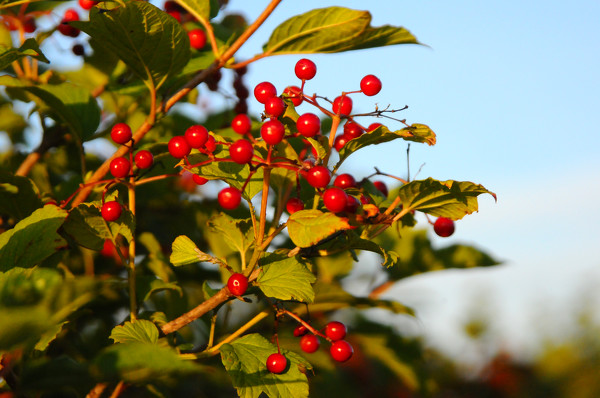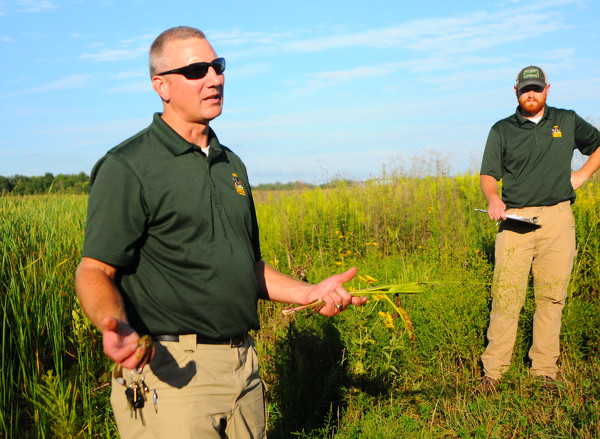Thursday, August 29th, 2019
A Healthy Habitat
Experts share advice on managing vulnerable environment
By Sydney Albert

Photo by Sydney Albert/The Daily Standard
Cranberries shine in the sun on Jack Leffel's property Tuesday. A row of cranberry trees, as well as other rows of saplings including species like sawtooth oak, are intended to serve as a windbreak for the grassland and wetland areas on the property near Wapakoneta.
WAPAKONETA - Dozens of habitat managers enrolled in programs such as the U.S. Department of Agriculture Conservation Reserve Program gathered Tuesday to hear and share tips on wetlands, grassland and windbreak management.
A workshop on upland wildlife habitat management offered tips on controlling noxious and invasive plant species that might appear and a gave a firsthand look at a nearby farm that had been partially converted into conservation land.
Proper control of noxious weeds in reconstructed grassland and wetlands is important, Jeff Stachler of the Auglaize County Ohio State University Extension explained. The seeds of some weeds can be dispersed on the wind and spread to neighboring properties, where it can pose a threat to farming operations. Cressleaf groundsel, for instance, can spread on the wind and is poisonous to livestock, he said.
Other plants can become, or already are, herbicide resistant. Part of the reason Auglaize County has struggled with resistant water hemp is because of mismanagement, Stachler said. Now, water hemp that's resistant to three types of treatment has gotten a foothold in the area. It can still be handled with careful management, but landowners need to take care to prevent the plants from developing any further resistance.
While nothing requires landowners to control invasive species on their properties, they are prevented by law from selling, propagating or distributing them. An attendee noted that one species on the current invasive species list, multiflora rose, was once recommended by the USDA. Stachler said the use of some species has changed over time.
At the conclusion of Stachler's presentation, which discussed how to identify similar species and when to apply certain treatments, attendees drove to a nearby farm owned by Jack Leffel, who has 26 acres enrolled in CRP. A portion of the land has been converted into wetlands over the past nine years, and representatives from the Division of Wildlife, Division of Forestry and Pheasants Forever discussed elements of a healthy habitat.
The biologists speaking at the workshop said Leffel's land was well maintained but had areas that could be improved. Several attendees found they faced similar struggles.
Cattails, while good in moderation, can become a problem due to how aggressively they spread. They can quickly take over a wetland and choke out other flora, biologist John Kaiser explained. Mowing, drawing down wetland water and herbicide application when the cattails are flowering - is the best practice, he said.
A water control structure, which allows land owners to control the water flow and level in a wetland, is also important to maintain, Kaiser said. Regularly pulling out the stop boards and flushing the structure is good practice, but if water levels in a reconstructed wetland naturally fluctuate as wetlands are supposed to, it might not be necessary as often. He didn't recommend keeping high levels of water in the wetland year round.
Biologist Caleb Shields advised landowners to keep the dike of a constructed wetland mowed and clear of woody vegetation. Mowing could also help with other issues, he said. Muskrats can burrow into dikes. Keeping the grass low can help landowners know where to fill in burrows and when to set traps.
In the area not used for holding water, Leffel has maintained a natural grassland. Daniel Francis, a wildlife biologist with Pheasants Forever, said while diversity was helpful in supporting wildlife, the structure of grasslands was also integral. Quail chicks, for instance, are roughly the size of a pingpong ball. To move around, they would need a grassland to have a clumpy consistency at the bottom and good cover overhead.
Introducing disturbances to a grassland - burning, mowing or tilling - can also introduce variety or encourage certain grasses or forbs to grow depending on the timing.
Leffel is also working to maintain a windbreak consisting of rows of different tree species. Daniel Bartlett of the Division of Forestry noted the rows of cranberry trees on Leffel's property had done well, which was usually not the case. Other trees such as the walnut saplings had not shared that success.
Establishing and maintaining a windbreak has many hurdles, Bartlett said. Some people lose saplings to neglect. Saplings need about two years to stick up above the weeds and grasses, and some people leave them to fend for themselves. Other times, bad weather can be a killer. Depending on the species and the yearly conditions, saplings or even older trees can sometimes die. Unpredictable weather can't be helped, but Bartlett recommended people take into account their soil type and the general climate when choosing a species to plant.
Ironically, sometimes wildlife can hinder attempts to create a windbreak for their habitat. Deer can eat away at younger trees and bucks rubbing their antlers against them can sometimes be too much. Bartlett remembered one client had said the best habitat he'd created was one where he'd fenced the deer out - at least until the trees had become more established.
Experimenting could sometimes be the answer - one attendee said he had discouraged bucks by putting steel poles close to his saplings after he'd heard deer didn't like steel against their antlers. Mowing grass around the trees so they have less vegetation to compete with also helped, he said.
Leffel said he originally joined CRP and converted wetland because the area flooded every year. When it was farmland, he tended to earn only a fraction of the money he invested in crops every year, he told the newspaper. Now, the government rents the land, and it doesn't hurt that he enjoys hunting and the wildlife the habitat brings to his back door. Being part of the program was a revenue choice, and the wetlands were just another land-management tool, he said.
Next to the conservation land, Leffel still farms. When rains produce runoff from his active farmland, it flows into the wetland area, which helps filter out excess nutrients from fertilizers. That filter is important given the hot topic of water quality, he said.
"I think farmers, anybody, has a duty to do what's right for the environment," Leffel said.

Photo by Sydney Albert/The Daily Standard
John Kaiser, left, holds water plantain and duckweed as he discusses cattail management. Caleb Shields looks on. Kaiser and Shields, representatives of the Ohio Division of Wildlife, discussed tips for wetland management Tuesday at an upland wildlife habitat management workshop in Auglaize County.





